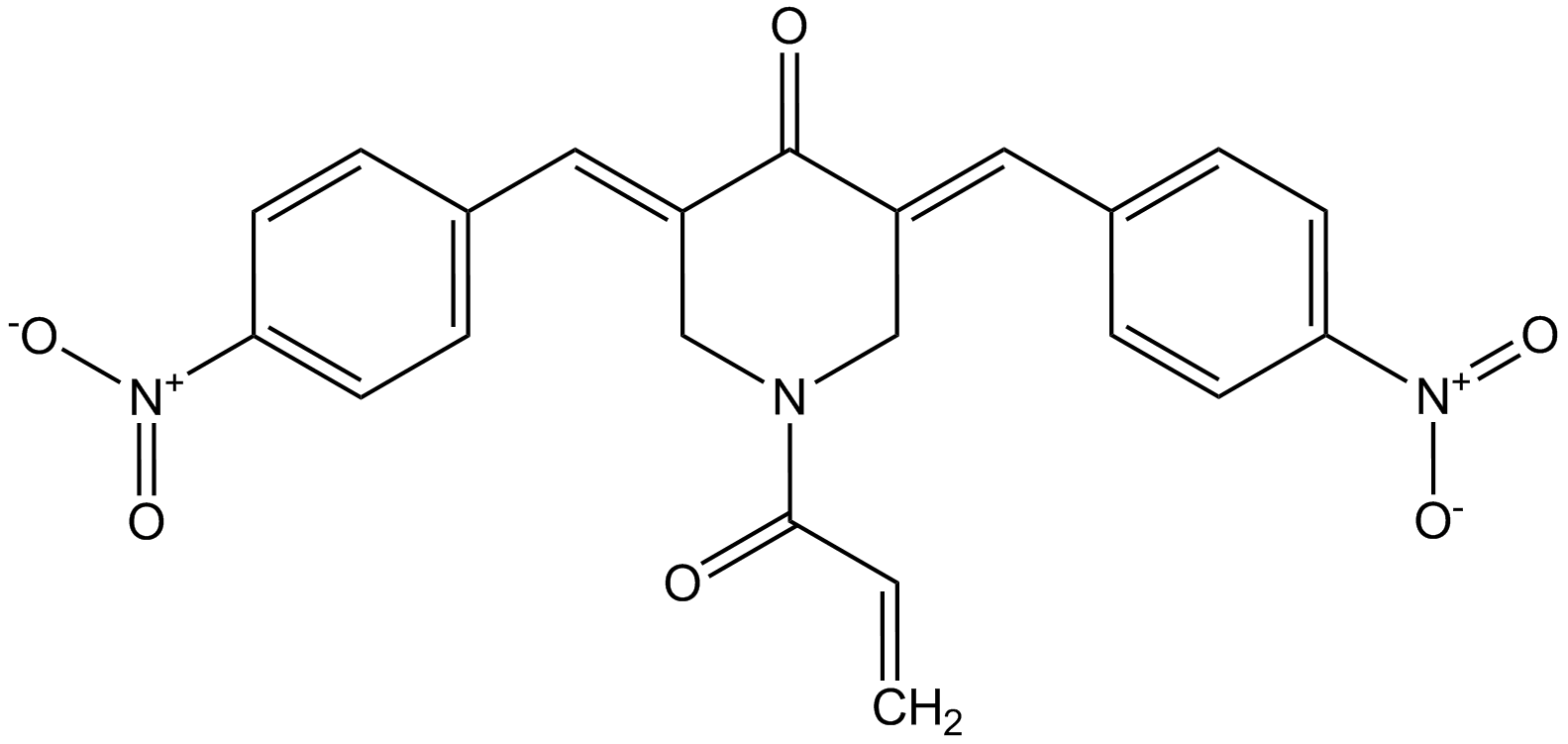b-AP15
| Code | Size | Price |
|---|
| AG-CR1-3552-M001 | 1 mg | £55.00 |
Quantity:
| AG-CR1-3552-M005 | 5 mg | £100.00 |
Quantity:
Prices exclude any Taxes / VAT
Overview
Regulatory Status: RUO
Shipping:
AMBIENT
Storage:
Short term storage:+4°C. Long term storage:-20°C.
Images
Documents
Further Information
Alternate Names/Synonyms:
NSC 687852; 3E,5E-bis[(4-Nitrophenyl)methylene]-1-(1-oxo-2-propen-1-yl)-4-piperidinone
Appearance:
Off-white to yellow solid.
CAS:
1009817-63-3
EClass:
32160000
Form (Short):
solid
GHS Symbol:
GHS08
Handling Advice:
Protect from light.
InChi:
InChI=1S/C22H17N3O6/c1-2-21(26)23-13-17(11-15-3-7-19(8-4-15)24(28)29)22(27)18(14-23)12-16-5-9-20(10-6-16)25(30)31/h2-12H,1,13-14H2/b17-11+,18-12+
InChiKey:
GFARQYQBWJLZMW-JYFOCSDGSA-N
Long Description:
Chemical. CAS: 1009817-63-3. Formula: C22H17N3O6. MW: 419.4. b-AP15 is a specific deubiquitinase (DUB) inhibitor. It inhibits ubiquitin-specific-processing protease 14 (USP14) and ubiquitin c-terminal hydrolase isozyme L5 (UCHL5; UCH37), two 19S regulatory particle proteasome-associated DUBs. It exhibits minimal inhibition of UCHL-1, UCHL-3, USP2, USP7, USP and BAP1. Has been described to inhibit also the 20S proteasome with an IC50 comparable to that required for inhibiting the 19S regulatory particles. b-AP15 has anticancer properties and blocks tumor progression in vivo in mice and prevents organ infiltration in mouse models of myeloid leukemia. b-AP15 also renders tumor cells sensitive to TNF-mediated apoptosis by natural killer and T cells. It induces apoptosis, ER stress and autophagy in several cancer cells. b-AP15 has anti-inflammatory properties inhibiting ERK1/2 and JNK phosphorylation, increasing IkappaBalpha levels and inhibiting NF-kappaB p65. b-AP15 inhibits the LPS/ATP-induced deubiquitination of NLRP3 and further increases NLRP3 ubiquitination. This leads to inhibition of NLRP3 activation, indicating that deubiquitination of NLRP3 by the priming and activation signals is critical for its activation.
MDL:
MFCD26142662
Molecular Formula:
C22H17N3O6
Molecular Weight:
419.4
Package Type:
Vial
Product Description:
b-AP15 is a specific deubiquitinase (DUB) inhibitor. It inhibits ubiquitin-specific-processing protease 14 (USP14) and ubiquitin c-terminal hydrolase isozyme L5 (UCHL5; UCH37), two 19S regulatory particle proteasome-associated DUBs. It exhibits minimal inhibition of UCHL-1, UCHL-3, USP2, USP7, USP and BAP1. Has been described to inhibit also the 20S proteasome with an IC50 comparable to that required for inhibiting the 19S regulatory particles. b-AP15 has anticancer properties and blocks tumor progression in vivo in mice and prevents organ infiltration in mouse models of myeloid leukemia. b-AP15 also renders tumor cells sensitive to TNF-mediated apoptosis by natural killer and T cells. It induces apoptosis, ER stress and autophagy in several cancer cells. b-AP15 has anti-inflammatory properties inhibiting ERK1/2 and JNK phosphorylation, increasing IkappaBalpha levels and inhibiting NF-kappaB p65. b-AP15 inhibits the LPS/ATP-induced deubiquitination of NLRP3 and further increases NLRP3 ubiquitination. This leads to inhibition of NLRP3 activation, indicating that deubiquitination of NLRP3 by the priming and activation signals is critical for its activation.
Purity:
>98%
SMILES:
O=C(N(C/C1=CC2=CC=C(C=C2)[N+]([O-])=O)C/C(C1=O)=CC3=CC=C(C=C3)[N+]([O-])=O)C=C
Solubility Chemicals:
Soluble in DMSO (20mg/ml).
Transportation:
Non-hazardous
UNSPSC Number:
12352200
Use & Stability:
Stable for at least 2 years after receipt when stored at -20°C.
References
Induction of the lysosomal apoptosis pathway by inhibitors of the ubiquitin-proteasome system: M. Berndtsson, et al.; Int. J. Cancer 124, 1463 (2009) | Inhibition of proteasome deubiquitinating activity as a new cancer therapy: P. D'Arcy, et al.; Nat. Med. 17, 1636 (2011) | A novel inhibitor of proteasome deubiquitinating activity renders tumor cells sensitive to TRAIL-mediated apoptosis by natural killer cells and T cells: D. Sarhan, et al.; Cancer Immunol. Immunother. 62, 1359 (2013) | Deubiquitinases Regulate the Activity of Caspase-1 and Interleukin-1beta Secretion via Assembly of the Inflammasome: G. Lopez-Castejon, et al.; J. Biol. Chem. Immunol. 288, 2721 (2013) | Proapoptotic effects of the novel proteasome inhibitor b-AP15 on multiple myeloma cells and natural killer cells: X. Feng, et al.; Exp. Hematol. 42, 172 (2014) | Inhibitory effect of b-AP15 on the 20S proteasome: L. Huang, et al.; Biomolecules 4, 931 (2014) | Oxidative Stress Induced by the Deubiquitinase Inhibitor b-AP15 Is Associated with Mitochondrial Impairment: X. Zhang, et al.; Oxid. Med. Cell Longev. 2019, 1659468 (2019) | Deubiquitinase Inhibitor b-AP15 Attenuated LPS-Induced Inflammation via Inhibiting ERK1/2, JNK, and NF-Kappa B: F. Zhang, et al.; Front. Mol. Biosci. 7, 49 (2020)



